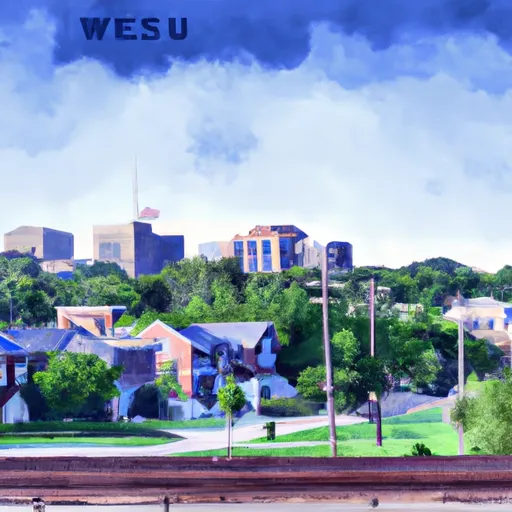-
 Snoflo Premium
Snoflo Premium
Get unlimited access to all our content
With no Ad interruptions! - Start Your Free Trial Login with existing account
West-Union
Eden Index
Climate
8.3
•
Recreation
2.0
•
Community
•
Safeguard
4.0/10

West Union is a small village located in Clark County, Illinois. The climate in West Union is characterized by hot and humid summers and cold winters. The average temperature in the summer months ranges from the mid-70s to low 90s Fahrenheit, while winters see temperatures dropping to the 20s and 30s. Precipitation is evenly distributed throughout the year, with an annual average of around 40 inches.
Hydrologically, West Union benefits from its proximity to the Embarras River, which flows nearby. The river provides recreational opportunities such as fishing, canoeing, and kayaking. Anglers can find a variety of fish species in the river, including catfish, bass, and crappie.
Outdoor recreation opportunities in West Union extend beyond the river. The surrounding area offers ample opportunities for hiking, camping, and birdwatching. Local parks and nature preserves provide scenic trails and picnic areas for visitors to enjoy the natural beauty of the region.
Overall, West Union, Illinois offers a diverse climate, access to the Embarras River, and a range of outdoor recreation opportunities, making it an attractive destination for nature enthusiasts and those seeking outdoor adventure.
What is the Eden Index?
The Snoflo Eden Index serves as a comprehensive rating system for regions, evaluating their desirability through a holistic assessment of climate health, outdoor recreation opportunities, and natural disaster risk, acknowledging the profound impact of these factors on livability and well-being.
Climate Health Indicator (CHI): 8.3
West-Union receives approximately
1103mm of rain per year,
with humidity levels near 81%
and air temperatures averaging around
13°C.
West-Union has a plant hardyness factor of
6, meaning
plants and agriculture in this region thrive during a short period during spring and early summer. Most
plants will die off during the colder winter months.
By considering the ideal temperature range, reliable water supplies, clean air, and stable seasonal rain or snowpacks, the Climate Health Indicator (CHI) underscores the significance of a healthy climate as the foundation for quality living.
A healthy climate is paramount for ensuring a high quality of life and livability in a region, fostering both physical well-being and environmental harmony. This can be characterized by ideal temperatures, reliable access to water supplies, clean air, and consistent seasonal rain or snowpacks.
Weather Forecast
Streamflow Conditions
Wabash
Area Rivers
Wabash
Snowpack Depths
Wabash
Reservoir Storage Capacity
Wabash
Groundwater Levels
Recreational Opportunity Index (ROI): 2.0
The Recreational Opportunity Index (ROI) recognizes the value of outdoor recreational options, such as parks, hiking trails, camping sites, and fishing spots, while acknowledging that climate plays a pivotal role in ensuring the comfort and consistency of these experiences.
Access to outdoor recreational opportunities, encompassing activities such as parks, hiking, camping, and fishing, is crucial for overall well-being, and the climate plays a pivotal role in enabling and enhancing these experiences, ensuring that individuals can engage in nature-based activities comfortably and consistently.
Camping Areas
| Campground | Campsites | Reservations | Toilets | Showers | Elevation |
|---|---|---|---|---|---|
| Meriwether Lewis | 32 | 963 ft | |||
| Ouabache Trails County Park | 45 | 446 ft | |||
| Mill Creek Park | 140 | 657 ft | |||
| Robinson City Park | None | 541 ft | |||
| Destiny Parks Military - Fort Campbell | None | 544 ft | |||
| Lincoln Trail State Park | 240 | 655 ft | |||
| Red Hills Lake State Park | 130 | 519 ft | |||
| Lincoln Trail | None | 412 ft | |||
| Kimmell City Park | 10 | 415 ft | |||
| Bumpus Mills - Lake Barkley | None | 520 ft |
Nearby Ski Areas
Catastrophe Safeguard Index (CSI):
The Catastrophe Safeguard Index (CSI) recognizes that natural disaster risk, encompassing floods, fires, hurricanes, and tornadoes, can drastically affect safety and the overall appeal of an area.
The level of natural disaster risk in a region significantly affects safety and the overall livability, with climate change amplifying these risks by potentially increasing the frequency and intensity of events like floods, fires, hurricanes, and tornadoes, thereby posing substantial challenges to community resilience and well-being.
Community Resilience Indicator (CRI):
The Community Resilience Indicator (CRI) recognizes that education, healthcare, and socioeconomics are crucial to the well-being of a region. The CRI acknowledges the profound impact of these elements on residents' overall quality of life. By evaluating educational resources, healthcare accessibility, and economic inclusivity, the index captures the essential aspects that contribute to a thriving community, fostering resident satisfaction, equity, and social cohesion.

